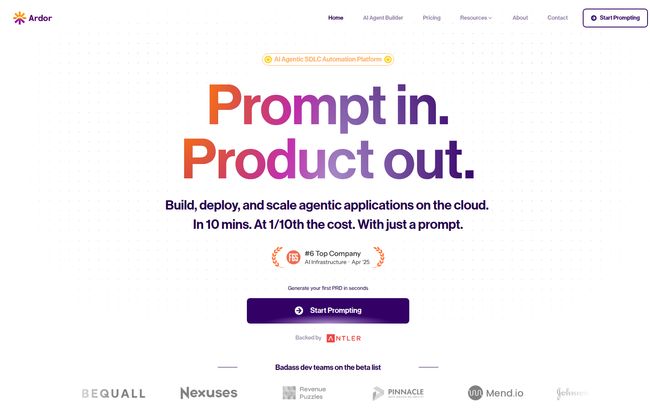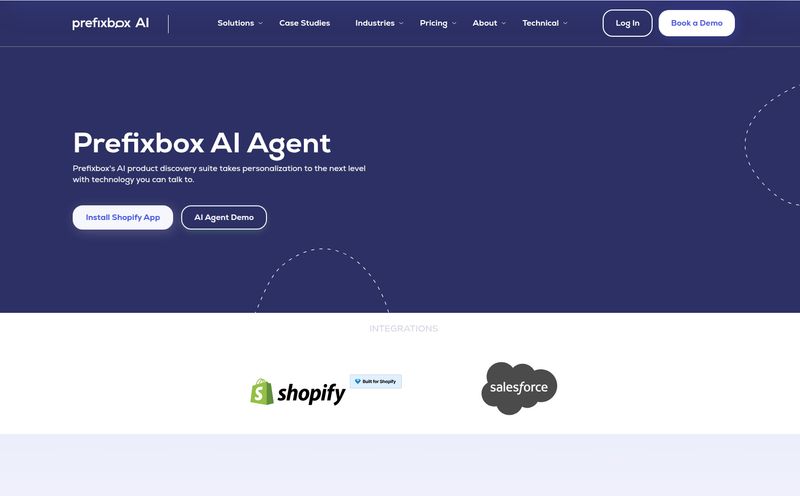If you’ve spent any time in the AI development space lately, you know the feeling. It’s a bit like a wild gold rush. You've got your pickaxe (your brilliant idea for an AI agent), but to get to the gold, you need a shovel, a sifting pan, a mule, a cart, a map... you get the picture. You're stitching together different frameworks, a vector database, cloud services, and monitoring tools. It's a patchwork quilt of tech that can come apart at the seams at any moment.
I’ve been in that trench, and frankly, it's exhausting. The amount of time spent on wrangling infrastructure instead of, you know, building the actual product is just maddening. So when I saw Ardor’s headline – “Prompt in. Product out.” – my inner skeptic raised a very prominent eyebrow. Could it really be that simple? An all-in-one platform to build, deploy, and scale AI agents? I had to take a look.

Visit Ardor
So, What is Ardor, Really?
Ardor calls itself an “agentic software development lifecycle (SDLC) automation platform.” That’s a mouthful, I know. Let's break it down into human speak. Think of it as a super-smart project manager, architect, and DevOps engineer all rolled into one slick interface. Instead of you manually designing every piece of your AI application’s architecture and then painstakingly setting up the deployment pipeline, Ardor aims to do the heavy lifting for you. It’s built for creating 'agents' – AI systems that can perform tasks, reason, and interact. The whole idea is to take you from a simple idea, expressed in a prompt, to a fully functioning, scalable product without the usual chaos.
Putting an End to the Tool Juggle
The single biggest thing that grabbed my attention is Ardor’s mission to stop the tool juggling. We've all been there. You have one tab open for your code, another for your cloud console, a third for your logging service, a fourth for your team’s chat... it’s a productivity nightmare. Ardor’s proposition is to bring all of that under one roof. This isn’t just about convenience; it’s about speed and sanity. When your whole workflow is in one place, you can iterate faster, debug more efficiently, and get your product to market before your competition. Fewer tools also means fewer subscription bills to pay and less operational overhead. That’s music to the ears of any startup or lean team.
How Does Ardor Actually Work?
This is where it gets interesting. It's not just a black box where you throw a prompt in and hope for the best. There’s a logical, developer-friendly flow.
The Magic Starts with Ardor Copilot
It all begins with a conversation. You literally tell the Ardor Copilot what you want to build. For instance, “Build me a customer support agent that can access our knowledge base to answer user questions.” The Copilot doesn't just spit out code. It suggests a complete architecture for you on a visual canvas. It’s like brainstorming with a senior engineer who instantly sketches out the blueprints. You can see all the components, how they connect, and what the data flow looks like. This is the “prompt to product” idea in action, and it’s a powerful starting point.
The Ardor Canvas: Your Visual Playground
Once the Copilot lays out the initial design, you’re not stuck with it. You get to play on the Ardor Canvas. They describe it as using LEGO-like components, and that’s a pretty spot-on analogy. You can drag, drop, and connect different nodes—things like data inputs, specific AI models, logic functions, or outputs. Want to swap out GPT-4 for another model? It’s a click away. Need to add a custom piece of Python code? You can create a custom node for that. It’s this blend of low-code visual building and the ability to drop down into real code that makes it flexible. And for teams, the whole thing is collaborative in real-time. You can see your teammate tweaking a node while you work on another. Kinda cool.
One Click to the Clouds
Deployment is often where the real headaches begin. Ardor tries to make this a non-issue. You get two main options: deploy directly on their optimized Ardor Cloud or—and this is a huge plus in my book—deploy to your own cloud infrastructure (AWS, GCP, Azure). This flexibility is critical. Some companies have strict data policies or existing agreements with cloud providers, so not being locked into Ardor's own hosting is a massive advantage. Features like 1-click model deployment, hot-swapping models without downtime, and serverless scalability are all designed to handle the gnarly bits of DevOps so you don't have to.
Ardor Pricing: What's the Real Cost?
Alright, let's talk money. A tool can be the greatest thing since sliced bread, but if the pricing is out of whack, it's a non-starter. Ardor’s pricing is thankfully pretty straightforward, but there are two parts you need to understand.
The Subscription Tiers
They offer a classic tiered model which seems aimed at growing with you:
- Basic ($0/month): This is your free tier. It’s for individuals and small teams just dipping their toes in. You get the core experience with the Ardor Copilot and the Visual Canvas. It’s generous enough to let you actually build something and see if the platform works for you.
- Pro ($40/month per seat): This is for growing teams and businesses that are getting serious. It adds crucial features like proactive monitoring, granular access controls for your team, and Single Sign-On (SSO).
- Enterprise (Custom Pricing): For the big players. You get everything in Pro plus all the custom support, security, and deployment options a large organization would need.
Don't Forget the Pay-As-You-Go Compute
This is the second part of the cost, and it's important. On top of your subscription, you pay for the actual computing resources your agents use. This is a standard model for cloud platforms, and it’s fair – you only pay for what you consume. They break it down into vCPU-seconds, vRAM-seconds, and Storage per GB. The rates seem competitive, but you absolutely need to factor this in. Your final bill isn't just $40; it's $40 plus whatever compute your application required. It’s a transparent model, but one you need to monitor as you scale.
The Good and The... Less Good
No tool is perfect. After my analysis, here’s my balanced take:
What I really like is the sheer simplification of a ridiculously complex process. The ability to go from an idea to a scalable architecture in minutes is a genuine accelerator. The flexibility to deploy on your own cloud is a masterstroke, avoiding the vendor lock-in that so many of us fear. And the collaborative, visual canvas feels like a much more intuitive way to build and manage these systems than staring at endless lines of config files.
What you should keep in mind, however, is that there might be a learning curve. While it's low-code, mastering the Ardor Canvas to build truly sophisticated agents will probably take some time. You're also placing a lot of your core SDLC process into a single platform, which creates a dependency. And while the pricing model is clear, the exact costs aren't plastered on the homepage; you have to go to the pricing page to see the details, which is a minor hurdle.
Final Thoughts: Is Ardor Worth the Hype?
So, is Ardor the magic bullet for AI development? No, there's no such thing. But is it a massive step in the right direction? I think so. It's a powerful tool that seems to genuinely understand the frustrations of modern developers in the AI space.
It’s not for everyone. If you're a massive enterprise with deeply entrenched, custom DevOps tooling, this might be a tough sell. But if you’re a startup, a scale-up, or a product team within a larger company that wants to move fast and focus on building innovative AI agents rather than managing infrastructure, Ardor looks incredibly promising. It takes away the undifferentiated heavy lifting and lets you focus on what actually matters: creating a great product.
For me, the promise of going from prompt to product isn't just marketing fluff. It's a real attempt to change the development paradigm, and from what I can see, it's a very, very strong attempt.
Frequently Asked Questions
- Can I upgrade or downgrade my plan at any time?
- Yes, platforms like this are typically built for flexibility. You should be able to change your plan (e.g., from Basic to Pro) as your team's needs change. The billing would then be adjusted accordingly.
- What are the costs beyond the monthly subscription?
- The main additional cost is for hardware and compute resources. This is a pay-as-you-go model where you are billed for the vCPU, vRAM, and storage your AI agents consume. This is separate from the flat monthly subscription fee for the plan tier.
- Am I charged for my AI Agent when it's not processing any requests?
- Based on the pay-as-you-go model for compute, you would likely incur minimal costs for an idle agent, mostly for any provisioned storage. However, active processing (using CPU and RAM) is what drives the bulk of the usage-based costs, so an idle agent is significantly cheaper than an active one.
- What kind of payment methods does Ardor accept?
- Most modern SaaS platforms accept all major credit cards. For Enterprise plans, they often provide options for invoicing and bank transfers to accommodate corporate procurement processes.
- Is Ardor a good choice for a solo developer?
- Absolutely. The free Basic plan is specifically designed for individuals and small teams. It gives you access to the core features, allowing a solo developer to build and test ideas without any initial financial commitment, only paying for compute if and when their agent gets used.



